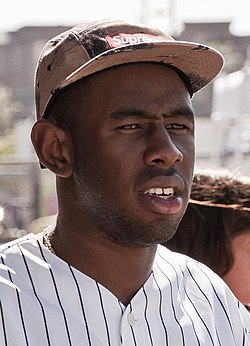Last Updated on April 6, 2025 by Bertrand Clarke
Tyler Gregory Okonma, better known as Tyler, the Creator, is not your typical rap icon. He’s a sonic architect, a visual provocateur, and a relentless innovator who has carved his own idiosyncratic path through the ever-evolving landscape of music and popular culture. His journey, marked by controversy, creative explosions, and a constant pursuit of artistic evolution, is a testament to the power of self-belief and the rewards of defying expectations. This is the story of how a restless kid from Hawthorne, California, became one of the most influential and enigmatic figures of his generation.
Roots in Rebellion: The Early Years
Tyler’s story begins in the sprawling suburbs of Los Angeles County. Born in 1991 to a Nigerian father he never met and an African-American mother he deeply admires, Tyler’s childhood was marked by a sense of otherness and a yearning for creative expression. He bounced between living in Hawthorne and Ladera Heights, attending twelve different schools throughout his formative years, a testament to the instability and restlessness that defined his early life.
This instability, however, fueled his resourcefulness. Lacking traditional outlets, Tyler found solace and purpose in the burgeoning online world. He taught himself graphic design, photography, and video editing, skills he would later leverage to build his unique brand. His fascination with music, particularly the boundary-pushing sounds of Pharrell Williams and Eminem, became an obsession. He spent countless hours experimenting with music production software, honing his skills and developing his signature sound: a raw, unfiltered blend of hip-hop, punk rock, and electronic music.
The Odd Future Collective: A Breeding Ground for Chaos and Creativity
The turning point in Tyler’s life came with the formation of Odd Future Wolf Gang Kill Them All (OFWGKTA), a collective of young, like-minded artists who shared a similar disdain for the mainstream and a burning desire to create something new. Emerging from the depths of the Los Angeles underground, Odd Future, spearheaded by Tyler’s chaotic vision, was a force to be reckoned with. The group, featuring talents like Earl Sweatshirt, Frank Ocean, Hodgy Beats, and Domo Genesis, became synonymous with provocative lyrics, lo-fi production, and a rebellious spirit that resonated with a generation disillusioned with the status quo.
Tyler, as the de facto leader and primary producer, was the driving force behind Odd Future’s meteoric rise. His early mixtapes, such as “Bastard” (2009) and “Goblin” (2011), were shocking, confrontational, and undeniably captivating. Critics were divided, some praising his raw talent and unfiltered honesty, while others condemned his use of violent and misogynistic imagery. Regardless of the criticism, Odd Future had struck a nerve. They were the anti-establishment heroes of the internet age, and their music became a soundtrack for the disenfranchised.
Breaking Through: Controversy and Critical Acclaim
The controversy surrounding Tyler’s early work, while polarizing, inadvertently propelled him into the mainstream spotlight. His performances were legendary for their chaotic energy and unpredictable nature. He was a disruptor, challenging the conventions of hip-hop and pushing the boundaries of artistic expression.
However, the criticism also took a toll. Accusations of misogyny and homophobia plagued his early career, forcing him to confront the implications of his art. He eventually addressed these criticisms, expressing remorse for some of his past lyrics and acknowledging the need for greater sensitivity. This marked a turning point in his artistic evolution, a move towards greater self-awareness and a more nuanced approach to his craft.
A Shift in Sound: Embracing Vulnerability and Melody
By the mid-2010s, Tyler’s music began to undergo a significant transformation. He started to embrace melody, experimentation, and a more introspective lyrical style. His 2015 album, “Cherry Bomb,” was a bold departure from his earlier work, showcasing his growth as a producer and songwriter. While initially divisive, it’s now considered a pivotal album in his discography, demonstrating his willingness to experiment and push his creative boundaries.
This shift culminated in the release of “Flower Boy” in 2017, an album that marked a true artistic breakthrough. “Flower Boy” was a vulnerable and introspective exploration of identity, loneliness, and the search for self-acceptance. The album was critically acclaimed, earning him his first Grammy nomination for Best Rap Album. It was a clear signal that Tyler, the Creator, had evolved from a provocative enfant terrible into a mature and multifaceted artist.
Igor and Call Me If You Get Lost: A Triumphant Reinvention
Tyler’s reinvention continued with the release of “Igor” in 2019, a concept album exploring themes of infatuation, heartbreak, and identity. “Igor” was a sonic masterpiece, blending elements of R&B, soul, and electronic music into a cohesive and captivating whole. The album was a commercial and critical success, debuting at number one on the Billboard 200 and winning him his first Grammy Award for Best Rap Album.
In 2021, Tyler released “Call Me If You Get Lost,” a sprawling, ambitious album that paid homage to the mixtape era of hip-hop. The album was a nostalgic yet forward-thinking exploration of travel, luxury, and the complexities of relationships. It showcased his growth as a lyricist and producer, solidifying his position as one of the most innovative and influential artists of his generation. “Call Me If You Get Lost” also earned him his second Grammy Award for Best Rap Album, cementing his legacy as a true visionary.
Beyond Music: A Multi-Faceted Creative Vision
Tyler’s creative vision extends far beyond music. He’s a successful fashion designer, with his own clothing brand, Golf Wang, and collaborations with major brands like Converse. He’s a talented visual artist, directing his own music videos and designing album artwork. He even has his own television show, “Loiter Squad,” a sketch comedy series that showcases his absurdist humor and unique sensibility.
His ventures into fashion have been particularly successful, reflecting his bold and unconventional style. Golf Wang has become a staple in streetwear culture, known for its vibrant colors, playful designs, and inclusive message. His collaborations with Converse have produced some of the most sought-after sneakers in recent years, demonstrating his influence on contemporary fashion trends.
Lessons from the Creator: Inspiration for Aspiring Greatness
Tyler, the Creator’s journey is an inspiring one for anyone who dreams of achieving greatness. His story teaches us the importance of:
- Authenticity: Tyler has always been true to himself, even when it was unpopular. He refused to conform to expectations and paved his own path.
- Creativity: He is a relentless innovator, constantly experimenting with new sounds, styles, and mediums.
- Resilience: He faced criticism and controversy but never gave up on his vision. He learned from his mistakes and emerged stronger.
- Self-Belief: He believed in himself, even when others doubted him. He had the confidence to pursue his dreams, no matter how unconventional they seemed.
Tyler, the Creator, is more than just a rapper; he’s a cultural icon, a visionary artist, and a testament to the power of self-expression. His story is a reminder that anything is possible if you dare to be different, embrace your creativity, and never stop pushing the boundaries of what’s possible. He is an inspiration to aspiring artists and creatives around the world, proving that true greatness lies in the pursuit of authenticity and the unwavering belief in oneself. His journey, from a rebellious kid in Hawthorne to a Grammy-winning artist, is a testament to the transformative power of art and the enduring legacy of a true original.











